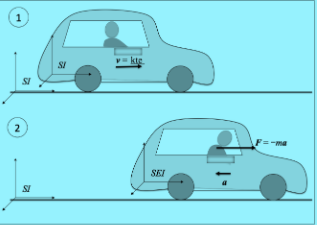
State Newton’s second law of motion. Prove that \[F = ma.\]
Answer
582.9k+ views
Hint:Newton’s second law says that force is the rate of change of momentum. The acceleration of the object is directly proportional to the force and inversely proportional to the mass.
Complete step-by-step answer:
According to Newton’s second law of motion, “The rate of change of momentum of a body is directly proportional to the force applied on it”. If, \[\vec p\] is the momentum of the body, m is the mass of the body and $\vec v$ is the velocity of the body then momentum is given below.
$\vec p = m\vec v$
Now let us write Newton’s second law of motion.
$\vec F \propto \dfrac{{d\vec p}}{{dt}}$
Where F is the force
Now, let us substitute the value of $\vec p$ and we get the following.
$\vec F \propto \dfrac{d}{{dt}}(m\vec v)$
Now, as we know mass m is constant then we can write the expression as following.
$\vec F \propto m\dfrac{d}{{dt}}(\vec v)$
Again, we can rewrite the above expression as below.
$\vec F \propto ma$ (Rate of change of velocity is acceleration: $\dfrac{{d\vec v}}{{dt}} = a$ )
We can replace the proportionality sign introducing a constant k.
$\vec F = kma$
If the proportionality constant k=1, then the above equation becomes
$\vec F = ma$
Where F is the force and has the unit of newton, m is the mass of unit kg and a is the acceleration of unit $m/{s^2}$
Hence, equation (1) is exactly Newton’s second law in mathematical form and equation (2) is the derived from (1) where we assumed that mass of the object to be constant and proportionality constant to be zero.
Note:
*To derive F=ma, we consider mass to be constant and proportionality constant to be unity.
*When we study relativistic mechanics where the speed of an object is nearly equal to speed of light (v ~ c) then F=ma does not apply. As at the higher speed nearly equal to speed of light mass no longer remains constant it becomes variable.

Complete step-by-step answer:
According to Newton’s second law of motion, “The rate of change of momentum of a body is directly proportional to the force applied on it”. If, \[\vec p\] is the momentum of the body, m is the mass of the body and $\vec v$ is the velocity of the body then momentum is given below.
$\vec p = m\vec v$
Now let us write Newton’s second law of motion.
$\vec F \propto \dfrac{{d\vec p}}{{dt}}$
Where F is the force
Now, let us substitute the value of $\vec p$ and we get the following.
$\vec F \propto \dfrac{d}{{dt}}(m\vec v)$
Now, as we know mass m is constant then we can write the expression as following.
$\vec F \propto m\dfrac{d}{{dt}}(\vec v)$
Again, we can rewrite the above expression as below.
$\vec F \propto ma$ (Rate of change of velocity is acceleration: $\dfrac{{d\vec v}}{{dt}} = a$ )
We can replace the proportionality sign introducing a constant k.
$\vec F = kma$
If the proportionality constant k=1, then the above equation becomes
$\vec F = ma$
Where F is the force and has the unit of newton, m is the mass of unit kg and a is the acceleration of unit $m/{s^2}$
Hence, equation (1) is exactly Newton’s second law in mathematical form and equation (2) is the derived from (1) where we assumed that mass of the object to be constant and proportionality constant to be zero.
Note:
*To derive F=ma, we consider mass to be constant and proportionality constant to be unity.
*When we study relativistic mechanics where the speed of an object is nearly equal to speed of light (v ~ c) then F=ma does not apply. As at the higher speed nearly equal to speed of light mass no longer remains constant it becomes variable.

Recently Updated Pages
Master Class 10 General Knowledge: Engaging Questions & Answers for Success

Master Class 10 Computer Science: Engaging Questions & Answers for Success

Master Class 10 English: Engaging Questions & Answers for Success

Master Class 10 Social Science: Engaging Questions & Answers for Success

Master Class 10 Maths: Engaging Questions & Answers for Success

Master Class 10 Science: Engaging Questions & Answers for Success

Trending doubts
The shortest day of the year in India

Why is there a time difference of about 5 hours between class 10 social science CBSE

Write a letter to the principal requesting him to grant class 10 english CBSE

What is the median of the first 10 natural numbers class 10 maths CBSE

The Equation xxx + 2 is Satisfied when x is Equal to Class 10 Maths

State and prove converse of BPT Basic Proportionality class 10 maths CBSE




